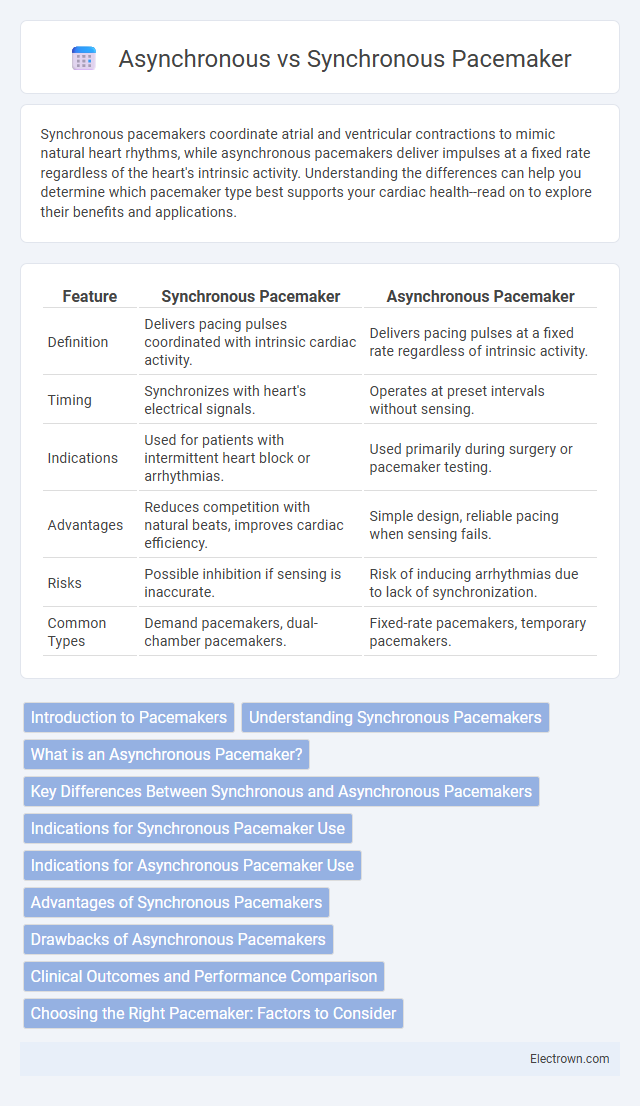Synchronous pacemakers coordinate atrial and ventricular contractions to mimic natural heart rhythms, while asynchronous pacemakers deliver impulses at a fixed rate regardless of the heart's intrinsic activity. Understanding the differences can help you determine which pacemaker type best supports your cardiac health--read on to explore their benefits and applications.
Table of Comparison
| Feature | Synchronous Pacemaker | Asynchronous Pacemaker |
|---|---|---|
| Definition | Delivers pacing pulses coordinated with intrinsic cardiac activity. | Delivers pacing pulses at a fixed rate regardless of intrinsic activity. |
| Timing | Synchronizes with heart's electrical signals. | Operates at preset intervals without sensing. |
| Indications | Used for patients with intermittent heart block or arrhythmias. | Used primarily during surgery or pacemaker testing. |
| Advantages | Reduces competition with natural beats, improves cardiac efficiency. | Simple design, reliable pacing when sensing fails. |
| Risks | Possible inhibition if sensing is inaccurate. | Risk of inducing arrhythmias due to lack of synchronization. |
| Common Types | Demand pacemakers, dual-chamber pacemakers. | Fixed-rate pacemakers, temporary pacemakers. |
Introduction to Pacemakers
Pacemakers are medical devices designed to regulate abnormal heart rhythms by delivering electrical impulses to the heart muscles. Synchronous pacemakers coordinate stimulus delivery with the heart's natural electrical activity, ensuring timely contractions, while asynchronous pacemakers emit impulses at fixed intervals regardless of intrinsic cardiac signals. Understanding the distinction between synchronous and asynchronous pacemakers is vital for tailoring therapy to patient-specific cardiac conditions and optimizing device performance.
Understanding Synchronous Pacemakers
Synchronous pacemakers coordinate with the heart's natural rhythm by sensing intrinsic cardiac activity and delivering pacing stimuli only when the heart's own rate falls below a preset threshold, optimizing cardiac function. These devices reduce the risk of competing impulses, preventing arrhythmias and promoting efficient myocardial contraction. By responding in real-time to the heart's electrical signals, synchronous pacemakers enhance patient safety and improve overall cardiac output.
What is an Asynchronous Pacemaker?
An asynchronous pacemaker delivers electrical impulses at a fixed rate regardless of the heart's intrinsic activity, ensuring continuous stimulation without sensing the heart's natural beats. This type of pacemaker is typically used in situations where sensing is unreliable or not possible, such as during certain surgical procedures or when electromagnetic interference may disrupt normal function. Your heart receives consistent pacing to maintain rhythm, but the lack of synchronization may cause competition between artificial and natural impulses.
Key Differences Between Synchronous and Asynchronous Pacemakers
Synchronous pacemakers coordinate pacing with the heart's intrinsic electrical activity, ensuring timing alignment with natural heartbeats, while asynchronous pacemakers emit impulses at a fixed rate regardless of the heart's rhythm. This key difference impacts how each device manages cardiac arrhythmias, with synchronous pacemakers reducing the risk of competition between natural and artificial impulses. Your choice between these pacemaker types depends on the specific cardiac condition and the need for rhythm coordination.
Indications for Synchronous Pacemaker Use
Synchronous pacemakers are primarily indicated for patients with atrioventricular (AV) block or sinus node dysfunction requiring coordinated atrial and ventricular pacing to maintain optimal cardiac output and rhythm. These devices preserve atrioventricular synchrony, preventing complications like pacemaker syndrome and improving hemodynamic performance. Your cardiologist may recommend synchronous pacing when intrinsic AV conduction is unreliable but atrial activity can still guide ventricular pacing effectively.
Indications for Asynchronous Pacemaker Use
Asynchronous pacemakers are primarily indicated during surgeries involving electrocautery or magnetic resonance imaging (MRI) where electromagnetic interference can disrupt normal pacing. You may also require an asynchronous mode if there is a risk of pacemaker inhibition due to inconsistent sensing or during emergencies when reliable pacing is crucial. This mode ensures continuous ventricular pacing regardless of intrinsic cardiac activity, preventing pauses or bradycardia in patients with complete heart block or significant conduction abnormalities.
Advantages of Synchronous Pacemakers
Synchronous pacemakers provide coordinated atrioventricular pacing, which maintains natural heart timing and optimizes cardiac output by preserving atrial contribution to ventricular filling. These devices reduce the risk of pacemaker syndrome by synchronizing atrial and ventricular contractions, resulting in improved hemodynamic performance. Clinical studies show synchronous pacing enhances exercise capacity and reduces symptoms in patients with atrioventricular block compared to asynchronous pacing.
Drawbacks of Asynchronous Pacemakers
Asynchronous pacemakers deliver electrical impulses at a fixed rate regardless of the heart's intrinsic activity, which can lead to competitive pacing and potentially dangerous arrhythmias. The lack of synchronization with the heart's natural rhythm may cause symptoms like palpitations, dizziness, or discomfort due to inappropriate pacing. Your risk increases if the device delivers impulses during vulnerable periods, highlighting the importance of choosing a pacemaker type suited to your specific cardiac condition.
Clinical Outcomes and Performance Comparison
Synchronous pacemakers coordinate atrial and ventricular contractions, improving hemodynamic efficiency and reducing the risk of atrial fibrillation compared to asynchronous pacemakers, which stimulate the heart without timing synchronization. Clinical outcomes demonstrate that synchronous pacing significantly lowers hospitalizations for heart failure and enhances left ventricular function by preserving atrioventricular synchrony. Performance comparisons reveal that synchronous devices provide superior rate responsiveness and patient quality of life, while asynchronous pacemakers may be reserved for specific cases such as complete heart block or when sensing capabilities are compromised.
Choosing the Right Pacemaker: Factors to Consider
Choosing the right pacemaker depends on your specific cardiac condition, with synchronous (dual-chamber) pacemakers offering coordinated atrial and ventricular pacing ideal for patients with AV block or sinus node dysfunction. Asynchronous (single-chamber) pacemakers deliver impulses to one chamber, suitable for patients with chronic atrial fibrillation or specific ventricular pacing needs. Factors such as heart rhythm, underlying pathology, lifestyle, and the risk of pacemaker syndrome are critical in determining the appropriate device for optimal cardiac function and quality of life.
Synchronous vs Asynchronous Pacemaker Infographic

 electrown.com
electrown.com